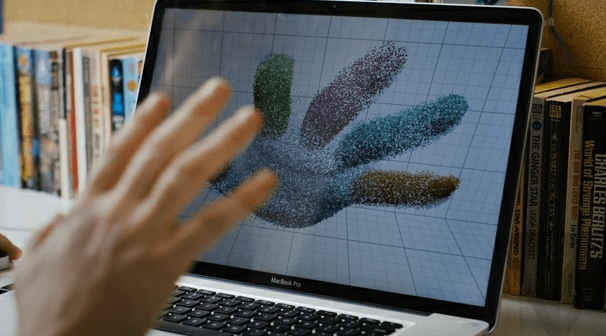
Will Interactive Digital Signage Take A Giant Leap With New Gesture Technology?
June 27, 2012 by Dave Haynes
Kinect applications for digital signage have left me pretty much cold because of accuracy issues and the necessary learning curve to make things happen. Despite the hype, I just don’t see it. The technology from a startup called Leap Motion is where gesture-driven public signage will go.
Leap Motion uses VGA camera sensors to track motion and give users mouse and touchpad level control accuracy on their gestures. So it’s not about waving an arm, it’s about twitching a finger.
The sensors accurately track gestures within a three cubic foot zone in front of a display. That will no doubt expand with time, but for one-to-one digital signage, close in is all you want and need.
Imagine not needing touch foil overlays on a window based display and just using a Leap system that is no bigger than a USB flash memory drive, at a fraction of the cost and delivering far better accuracy and therefore experience.
Imagine not having to worry about touch overlays and the ick factor of touching public displays during cold and flu season.
The Verge tech blog had a visit with the Leap Motion people and got a hands-on demo that showed accuracy down to the level of individual fingers, and the ability to distinguish a pencil from a finger.
The big difference with this and Kinect is with the latter gestures have to be mapped and basically taught to the system so they can be recognized and responded to. With Leap, the system is just responding to what you are doing.
Reports the blog:
Leap Motion’s plans are huge (Holz mentioned a few times wanting to totally upend traditional computing methods) but the company’s playing its cards close. The Leap will cost $70 when it’s released — sometime between December and February — and Leap Motion is also working with OEMs to embed its technology into devices. The Leap is about the size of a USB drive, but Holz says it could easily be no larger than a dime, so adding it to a laptop or tablet shouldn’t be difficult.
Developers are apparently beating down the company’s doors for access to the technology — Holz said thousands of Leaps will be given away in the next few months, before it’s released to the public. That’s no surprise: after only a few minutes of cutting fruit, scrolling around maps and webpages, and navigating through huge 3D spaces, all without ever touching a thing, we’re pretty sure we’ve seen the next big thing in computing.
$70 means this something that can be built into any design without busting budgets. It also means widespread adoption, which means using Leap will not have a learning curve.



Leave a comment